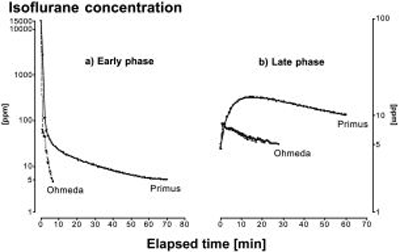Heike Prinzhausen, F.R.C.A., Mark W. Crawford, M.B.B.S., F.R.C.P.C, Guy C. Petroz, M.D.
Department of Anaesthesia, Hospital for Sick Children, Toronto, Ontario, Canada
Introduction: To prepare anesthesia machines for patients who are susceptible to malignant hyperthermia (MH), current guidelines recommend flushing the machine with a fresh gas flow (FGF) of 10 l/min for at least 10 min to washout residual anesthetic agents. 1 We compared the washout profiles for isoflurane in the Drager Primus Workstation and the Ohmeda Excel 210 anesthesia machine.
Methods: The machines were primed with 1.5% isoflurane in air for 2 h at a FGF of 2 l/min. Priming was
achieved using a circle breathing circuit, a test lung, and controlled ventilation with a tidal volume of 500 ml
and a respiratory rate of 15 breaths/min. At completion of priming, the isoflurane vaporizer was removed
from the machine, and the absorber, ventilator tubing, circle circuit, test lung, and ventilator bellows for the
Excel 210 were replaced with components that had not been exposed to anesthetics. A calibrated Miran
portable infrared Ambient Air Analyzer (with accuracy ± 5% and sensitivity 0.1 ppm) was used to measure
the isoflurane concentration in the inspiratory limb of the circle circuit every minute. To determine the
washout profile of isoflurane, the FGF was initially set at 10 l/min until a concentration of isoflurane of 5 ppm
was reached (Early Phase). Thereafter, the FGF was reduced to 3 l/min to simulate clinically relevant flows
during anesthesia, and the concentration of isoflurane was analyzed every minute for an additional hour
(Late Phase). Four Drager Primus and two Ohmeda Excel 210 machines were each studied in triplicate.
Mann-Whitney rank-sum test was used to compare the time to reach 5 ppm. P < 0.05 was onsidered
statistically significant.
Results: During the early phase of the washout, the isoflurane concentration decreased exponentially,
reaching 5 ppm at 64.4 ± 4.6 min (range: 56 - 70 min) and 6.7 ± 0.5 min (range: 6 - 7 min) in the Primus and
Excel 210 machines, respectively (P < 0.05) (Figure). During the late phase of the washout in the Primus,
the isoflurane concentration increased approximately threefold to 15.5 ± 0.9 ppm (range: 14.1 - 16.6 ppm)
and then decreased, but remained above 5 ppm for the remainder of the experiment. In contrast, during the
late phase of the washout in the Excel 210, the isoflurane concentration increased by approximately 65%,
returning to 5 ppm within a maximum of 28 min.
Conclusion: The washout for isoflurane was tenfold slower in the Primus than in the Excel 210. When preparing the Drager Primus for MH susceptible patients, we recommend flushing the workstation for at least 70 min with a FGF of 10 l/min and maintaining that FGF for the duration of anesthesia.

Figure 1